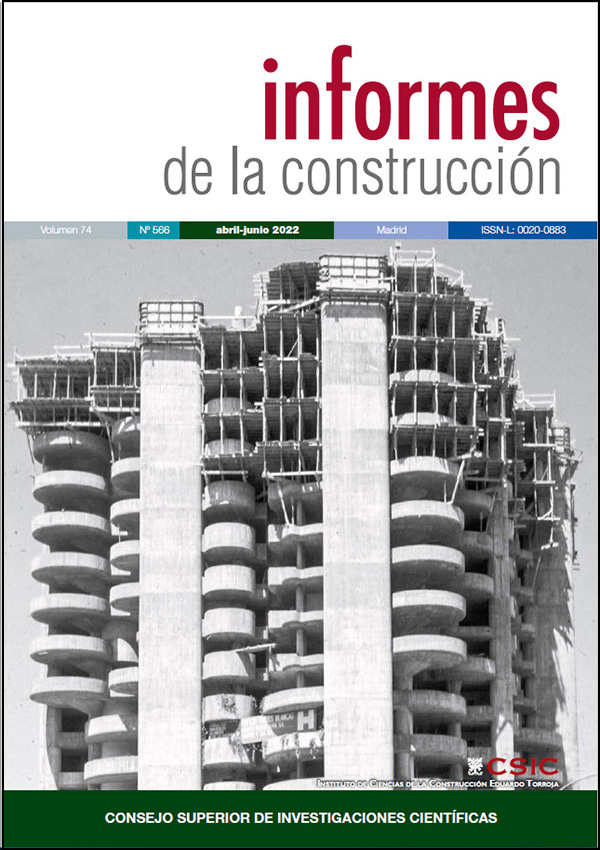Using change modes and effects analysis tool for explaining the ratio of flexibility and spatial organization in housing
DOI:
https://doi.org/10.3989/ic.84171Keywords:
housing, flexibility, spatial organization, change modes and effects analysisAbstract
Architectural spaces with the capability of spatial organization and internal transformations can respond to a greater number of their users’ needs at different times. The necessity to access this ability is one of the subcategories of flexibility in housing as a contemplative subject. The purpose of this research is to provide an analytical model in relation to understanding change modes and effects analysis tool and using its indicators to assess flexibility in housing. The research method in the present study will be of mixed type, and its performance method will be based on estimation and evaluation. The obtained results show that the spatial organization in residential complexes in Tehran city is based on applying possible changes in the spaces. This has led to the increased flexibility of spaces in relation to various activities.
Downloads
References
(1) Habibi, S.M., Ahari, Z. (1988). Minimal housing. Tehran: Ministry of Housing and Urban Development.
(2) Albostan, D. (2009). Flexibility in multi-residential housing projects: three innovative cases from Turkey (Master's thesis). Ankara: Middle East Technical University.
(3) Farmanfarmaian, A., Gruen, V. (1968). Tehran master plan. Tehran: Ministry of Housing and Urban Development.
(4) Eghbali, S.R., Hessari, P. (2013). Modular approach and prefabrication in flexible housing. Housing and Rural Environment, 32(143), 53-68.
(5) Ghafourian, M., Aghaei, S. (2016). Flexibility criteria for design of apartment housing in Iran. Soffeh, 26(3), 41-64.
(6) Gerwin, D. (1982). Do's and don'ts of computerized manufacturing. Harvard Business Review, 60(2), 107-116.
(7) Browne, J., Dubois, D., Rathmill, K., Sethi, S.P., Stecke, K.E. (1984). Classification of flexible manufacturing systems. Flexible Manufacturing Systems, 2(2), 114-117.
(8) Jaikumar, R. (1986). Postindustrial manufacturing. Harvard Business Review, 64(6), 69-76.
(9) Gerwin, D. (1987). An agenda for research on the flexibility of manufacturing processes. Operations and Production Management, 7(1), 38-49, https://doi.org/10.1108/eb054784
(10) Son, Y.K., Park, C.S. (1987). Economic measure of productivity, quality, and flexibility in advanced manufacturing systems. Manufacturing Systems, 6(3), 193-207. https://doi.org/10.1016/0278-6125(87)90018-5
(11) Sethi, A.K., Sethi, S.P. (1990). Flexibility in manufacturing: a survey. Flexible Manufacturing Systems, 2(4), 289-328, https://doi.org/10.1007/BF00186471
(12) Howe, D.A. (1990). The flexible house designing for changing needs. American Planning Association, 56(1), 69-77, https://doi.org/10.1080/01944369008975746
(13) Gosling, J., Naim, M., Sassi, P., Iosif, L., Lark, R. (2008). Flexible buildings for an adaptable and sustainable future. In 24th ARCOM Annual Conference, 1-3 September-2008. Cardiff: Association of Researchers in Construction Management.
(14) Shabani, M.M., Tahir, M.M., Arjmandi, H., Cheani, A.I., Abdullah, N.A.G., Usman, I.M.S. (2010). Achieving privacy in the Iranian contemporary compact apartment through flexible design. In 6th WSEAS International Conference, 4-6 October-2010. Iwate: Iwate Prefectural University.
(15) Rian, I.M., Sassone, M. (2012). Flexible housing, a healthy housing: a brief discussion about the merits of flexibility in designing healthy accommodation. In 2nd NUOVO International Conference, 12-13 December-2012. Naples: University of Naples Federico II.
(16) Abbaszadeh, S., Kalani Moghadam, M., Saadatian, O. (2013). Analyzing a proper flexible and adaptable pattern for promoting the housing quality in Iran. Design and Built, 6(1), 1-11.
(17) Seo, K.W., Kim, C.S. (2013). Interpretable housing for freedom of the body: the next generation of flexible homes. Building Construction and Planning Research, 1(3), 75-81, https://doi.org/10.4236/jbcpr.2013.13011
(18) Cellucci, C., Di Sivo, M. (2015). The flexible housing: criteria and strategies for implementation of the flexibility. Civil Engineering and Architecture, 9(7), 845-852, https://doi.org/10.17265/1934-7359/2015.07.011
(19) Estaji, H. (2017). A review of flexibility and adaptability in housing design. Contemporary Architecture, 4(2), 37-49.
(20) Ghafourian, M. (2018). Identification of flexible types in designing Iranian apartment housing. Iranian Architecture and Urbanism, 9(15), 63-73.
(21) Schneider, T., Till, J. (2005). Flexible housing: opportunities and limits. Architectural Research Quarterly, 9(2), 157-166, https://doi.org/10.1017/S1359135505000199
(22) Einifar, A. (2003). A model for flexibility analysis in Iranian traditional housing. Fine Arts, 13(13), 64-77.
(23) Heidari, T., Arian Mehr, A., Karimian Shamsabadi, M. (2018). Architecture of residential complexes and flexible housing in Iran with emphasis on adaptability. Urban Management, 17(50), 257-281.
(24) Hillier, B. (1996). Space is the machine. Cambridge: Cambridge University.
(25) Ching, F.D.K. (2018). Architecture: form, space, and order. Tehran: University of Tehran.
(26) Tilstra, A.H., Backlund, P.B., Seepersad, C.C., Wood, K.L. (2015). Principles for designing products with flexibility for future evolution. Mass Customisation, 5(1), 22-54, https://doi.org/10.1504/IJMASSC.2015.069597
(27) Keese, D.A., Seepersad, C.C., Wood, K.L. (2009). Product flexibility measurement with enhanced change modes and effects analysis (CMEA). Mass Customisation, 3(2), 115-145, https://doi.org/10.1504/IJMASSC.2009.023379
(28) Palani Rajan, P.K., Van Wie, M., Campbell, M.I., Wood, K.L., Otto, K.N. (2005). An empirical foundation for product flexibility. Design Studies, 26(4), 405-438. https://doi.org/10.1016/j.destud.2004.09.007
(29) Cochran, W.G. (1977). Sampling techniques. New York: John Wiley and Sons.
Published
How to Cite
Issue
Section
License
Copyright (c) 2022 Consejo Superior de Investigaciones Científicas (CSIC)

This work is licensed under a Creative Commons Attribution 4.0 International License.
© CSIC. Manuscripts published in both the print and online versions of this journal are the property of the Consejo Superior de Investigaciones Científicas, and quoting this source is a requirement for any partial or full reproduction.
All contents of this electronic edition, except where otherwise noted, are distributed under a Creative Commons Attribution 4.0 International (CC BY 4.0) licence. You may read the basic information and the legal text of the licence. The indication of the CC BY 4.0 licence must be expressly stated in this way when necessary.
Self-archiving in repositories, personal webpages or similar, of any version other than the final version of the work produced by the publisher, is not allowed.















